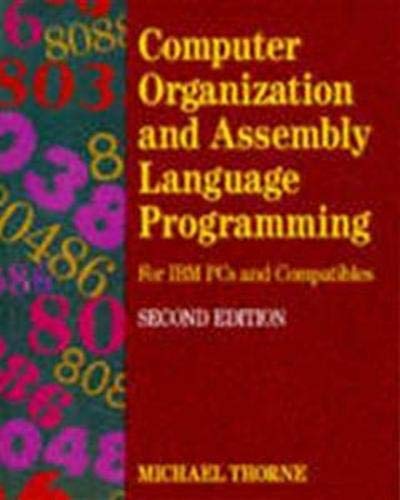Programming Language (6 results)
Search filters
Product Type
- All Product Types
- Books (6)
- Magazines & Periodicals (No further results match this refinement)
- Comics (No further results match this refinement)
- Sheet Music (No further results match this refinement)
- Art, Prints & Posters (No further results match this refinement)
- Photographs (No further results match this refinement)
- Maps (No further results match this refinement)
- Manuscripts & Paper Collectibles (No further results match this refinement)
Condition Learn more
- New (4)
- As New, Fine or Near Fine (No further results match this refinement)
- Very Good or Good (1)
- Fair or Poor (No further results match this refinement)
- As Described (1)
Binding
Collectible Attributes
- First Edition (1)
- Signed (No further results match this refinement)
- Dust Jacket (No further results match this refinement)
- Seller-Supplied Images (No further results match this refinement)
- Not Print on Demand (6)
Language (2)
Price
- Any Price
- Under £ 20 (No further results match this refinement)
- £ 20 to £ 35 (No further results match this refinement)
- Over £ 35
Free Shipping
- Free Shipping to U.S.A. (No further results match this refinement)
Seller Location
Seller Rating
-
The Scheme Programming Language Dybvig, R. Kent and Hebert, Jean-Pierre
Seller: Aragon Books Canada, OTTAWA, ON, Canada
Condition: New. Hebert, Jean-Pierre (illustrator).
-
The Scheme Programming Language Dybvig, R. Kent and Hebert, Jean-Pierre
Seller: Aragon Books Canada, OTTAWA, ON, Canada
Condition: New. Hebert, Jean-Pierre (illustrator).
-
Condition: New.
-
Condition: New.
-
Cobol 74 Programming Self-Instruction Course
Published by NCR Corporation, Dayton, Ohio, 1978
Seller: Kuenzig Books ( ABAA / ILAB ), Topsfield, MA, U.S.A.
Trade Paperback. Condition: Very Good. A set of Cobol 74 training program guides, including the Monitor Guide, Handbook, and Volumes 1, 2, 3, and 4 of the student's Self-Instruction Course. Includes the Final Exercise envelope to be opened by the Course Monitor after the student has completed all the course components as well as a nearly complete pad of blank Cobol Programming worksheets. The slipcase is worn and has minor damage to some of the corners and edges. The spines of the booklets are sun faded. Internally sound and generally clean. The second edition (first edition was the previous year). Trade Paperback. A group of modules for learning Cobol 74 Programming. The Monitor Handbook shows how the course monitor should teach the course and monitor student progress. The 4 volumes are for the students' use. The Handbook is more of a reference guide for the language. A complete educational package for both learning and monitoring students. These types of materials are becoming quite scarce, and are an important part of our computing heritage, often discarded as languages become obsolete and programmers learned the languages. COBOL was (and is) an important language for programming business applications. An acronym for "COmmon Business Oriented Language" COBOL was developed jointly by various industry competitors in the late 1950s and early 1960s. It has continued to evolve over time. Cobol 74 refers to compatibility with a particular ANSI standard for the language from 1974. See Sammet's "Programming Languages: History and Fundamentals" for a pre-1970's view of the history of computing languages including Cobol.
-
'Massachusetts Institute of Technology, Project MAC', MAC-TR-52 (Thesis): ABSENTEE COMPUTATIONS IN A MULTIPLE-ACCESS COMPUTER SYSTEM, by Harvey Michael Deitel S.B., Massachusetts Institute of Technology (1967). - Submitted in partial Fulfillment of the Requirements for the Degree of 'Master of Science' at the Massachusetts Institute of Technology, August 1968. - Thesis Supervisor: J. H. Saltzer, Title: Assistant Professor of Electrical Engineering. [MIT, M.I.T.; Project MAC 1968, Compatible time-sharing system, Electronic Computers]
Published by No printer mentioned (M.I.T., 1968)., 1968
Seller: C O - L I B R I , Bremen - Berlin ; Deutschland / Germany ., Berlin, Germany
First Edition
92 pages, with some graphics. - Publisher's grey-marbled titled cardboard-covers; 8vo.(ca. 22 x 16 cm). *** [WEIHNACHTS-VERKAUF bis Montag, den 29.12.2025 / CHRISTMAS-SALE until Monday, December 29, 2025: um über 30% REDUZIERTER PREIS / PRICE-REDUCTION of over 30%; ursprünglicher Preis / previously EUR 465,-] --- FIRST EDITION, SOFTCOVER ORIGINAL OF THE NEW APPROACH TO COMPUTATIONAL PRACTICS; SOFTCOVER ORIGINAL. Titlepage with ownership-stamp of the period 'Horst E.Willenberg, . . .'. - Cover slightly used, top sharp-corner slightly bumped; else in best condition. --- ''In multiple-access computer systems, emphasis has been placed upon servicing several interactive users simultaneously. However, many computations do not require interaction with the user, and the user may therefore want to run these computations 'absentee' (or user not present). A mechanism is presented which provides for the handling of absentee computations in a multiple-access computer system. The design is intended to be implementation-independent; the specifications for each module in the mechanism are presented in terms of the primitive functions which comprise the module. Perhaps the most novel features of the design are the ability for a user to switch one of his computations from interactive to absentee (and vice versa), the ability for the system to temporarily suspend and then continue absentee computations to aid in maintaining an efficient absentee-interactive workload on the system, the ability for system administrative personnel to apportion system resources between interactive and absentee computations in order to place emphasis upon a particular mode during certain periods of operation, and the multiple-computation-stream facility of the system which allows the user to attach priorities to his absentee computations by placing the computations in either low-, standard-, or high-priority streams.''('Abstract').





